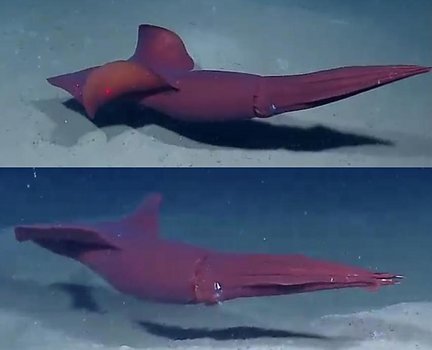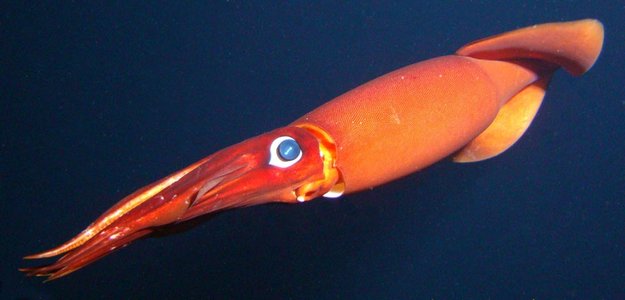Pholidoteuthidae
Pholidoteuthis
Michael Vecchione and Richard E. YoungThe family contains the following two rather dissimilar species:
- Pholidoteuthis adami Voss, 1956
- Pholidoteuthis massyae (Pfeffer, 1912)
Introduction
The two species in the family are large (P. massyae 72 cm ML; P. adami:78 cm ML) but moderate to somewhat weakly-muscled squids. P. adami has been reported to be common in the Gulf of Mexico (Voss, 1956) and is fairly common in the slope water of the North West Atlantic to at least New England (MV, pers. observation). P. massyae is thought to be cosmopolitan in tropical and temperate seas. Squids from different oceans, however, have not been closely compared.


Figure. ROV photographs of Pholidoteuthis sp. (probable ID), swimming near the ocean floor at 1359 m depth in the Gulf of Mexico. Bottom image taken seconds after the top image shows an apparent vertical pupil. © NOAA
Brief diagnosis:
A member of the lepidoteuthid families ...
- with elongate tentacular clubs lacking a locking apparatus.
- with dermal cushions or papillose tubercules.
Characteristics
- Arms
- Arms with biserial suckers present; hooks absent.
- Arms with biserial suckers present; hooks absent.
- Tentacles
- Long, slender clubs, only slightly expanded.
- Length of manus ca. 2 times length of dactylus.
- Locking-apparatus absent or greatly reduced. See P. massyae page.
- Small flaps with short membranes present near bases of lateral club suckers (=abortive trabeculae ?); flaps not attached to protective membrane (see arrows in photograph below).
- Suckers in four series.
- Suckers with elongate apertures.
- Mantle
- Conspicuous dermal cusions or papillose tubercules present (see species accounts).
- Conspicuous dermal cusions or papillose tubercules present (see species accounts).
- Photophores
- Absent.
Comments
Major differences between species are:- The dermal cushions of P. adami are very different from the mushroom-shaped papillose tubercules of P. massyae
- The gladii are very different with P. adami having a secondary conus and P. massyae having apparently a primary conus and very differently shaped vanes.
- P. adami has large fins and long arms and P. massyae short fins and short arms.
The two species look very different, but the nearly identical tentacular clubs, which are very peculiar, clearly indicates close relationship.
Nomenclature
Two genera have been placed in this family: Tetronychoteuthis and Pholidoteuthis. Pfeffer erected the genus Tetronychoteuthis in 1900 based on a specimen he incorrectly thought to be Onychoteuthis dussumieri Orbigny, 1839 but was actually a specimen of Tetronychoteuthis massyae, a species he described in 1912. Onychoteuthis dussumieri Orbigny, 1839, however, is a species of Onykia (formerly Moroteuthis) (Onychoteuthididae) (Roper and Lu, 1989; Nesis and Nikitina, 1990). Pholidoteuthis was erected by Adam (1950) for his new species Pholidoteuthis boschmai. Nesis and Nikitina (1990) demonstrated that Adam's species and that described by Pfeffer as Tetronychoteuthis massyae belong in the same genus. They considered Tetronychoteuthis to be a nomina dubia, leaving Pholidoteuthis as the valid generic name. According to Roper and Lu (1989), the case must be referred to the International Commission on Zoological Nomenclature. More recently O'Shea, et al. (2007) placed P. boschmai as the junior synonym of P. massyae.
A list of all nominal genera and species in the Pholidoteuthidae can be found here. The list includes the current status and type species of all genera, and the current status, type repository and type locality of all species and all pertinent references.
References
Adam, W. 1950. Un cephalopode nouveau: Pholidoteuthis boschmai gen. Et sp. Nov. Koninklijke Nederlandse Akademie van Wetenschappen, 53: 1-8.
Pfeffer, G. 1900. Synopsis der oegopsiden Cephalopoden. Mitt. Hamburgischen Zoologische Museum.17: 147-198.
Goldman, D. A. 1995. A juvenile of the scaled squid, Pholidoteuthis adami Voss, 1956 (Cephalopoda: Oegopsida), from the Florida Keys. Proc. Biol. Soc. Wash. 108: 136-146.
Nesis, K.N. and I.V. Nikitina. 1990. Revision of the squid family Lepidoteuthidae. Zool. Zhurnal, 69: 39-49.
Orbigny, A. d'. 1834-1848. In: A. de Ferussac and A. d'Orbigny. Histoire naturelle generale et particuliere cephalopodes acetabuliferes vivants et fossiles. Paris.
Roper, C.F.E. and C.C. Lu. 1989. Systematic status of Lepidoteuthis, Pholidoteuthis and Tetronychoteuthis (Cephalopoda: Oegopsida). Proc. Biol. Soc. Wash., 102: 805-807.
Roper, C.F.E. and C.C. Lu. 1990. Comparative morphology and function of dermal structures in oceanic squids (Cephalopoda). Smithson. Contr. Zool., No. 493: 1-40.
Sweeney, M. J. and C. F. E. Roper. 1998. Classification, type localities and type repositories of Recent Cephalopoda. Smithson. Contr. Zool., No. 586 (vol. II): 561-599.
Voss, G. L. 1956. A review of the cephalopods of the Gulf of Mexico. Bull. Mar. Sci. Gulf Carib. 6:85-178.
Title Illustrations

| Scientific Name | Pholidoteuthis |
|---|---|
| Location | Mississippi Canyon, Gulf of Mexico |
| Comments | The high resolution image (ie, click on image) shows the diagnostic dermal cushions. |
| Acknowledgements | Dr. Mark Benfield, Louisiana State University. |
| Specimen Condition | Live Specimen |
| Identified By | M. Vecchione |
| View | Lateral |
| Copyright | © NRDA (Natural Resource Damage Assessment |
About This Page

National Museum of Natural History, Washington, D. C. , USA

University of Hawaii, Honolulu, HI, USA
Page copyright © 2019 and
 Page: Tree of Life
Pholidoteuthidae . Pholidoteuthis .
Authored by
Michael Vecchione and Richard E. Young.
The TEXT of this page is licensed under the
Creative Commons Attribution-NonCommercial License - Version 3.0. Note that images and other media
featured on this page are each governed by their own license, and they may or may not be available
for reuse. Click on an image or a media link to access the media data window, which provides the
relevant licensing information. For the general terms and conditions of ToL material reuse and
redistribution, please see the Tree of Life Copyright
Policies.
Page: Tree of Life
Pholidoteuthidae . Pholidoteuthis .
Authored by
Michael Vecchione and Richard E. Young.
The TEXT of this page is licensed under the
Creative Commons Attribution-NonCommercial License - Version 3.0. Note that images and other media
featured on this page are each governed by their own license, and they may or may not be available
for reuse. Click on an image or a media link to access the media data window, which provides the
relevant licensing information. For the general terms and conditions of ToL material reuse and
redistribution, please see the Tree of Life Copyright
Policies.
- Content changed 26 March 2019
Citing this page:
Vecchione, Michael and Richard E. Young. 2019. Pholidoteuthidae . Pholidoteuthis . Version 26 March 2019 (under construction). http://tolweb.org/Pholidoteuthis/19835/2019.03.26 in The Tree of Life Web Project, http://tolweb.org/








 Go to quick links
Go to quick search
Go to navigation for this section of the ToL site
Go to detailed links for the ToL site
Go to quick links
Go to quick search
Go to navigation for this section of the ToL site
Go to detailed links for the ToL site